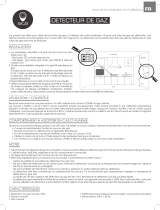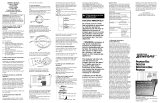
6
WARNING Starter and other rotating parts could entangle
hands, hair, clothing, or accessories resulting in
serious injury.
• NEVER operate generator without protective housings, covers, or
guards in place.
• DO NOT wear loose clothing, jewelry or anything that could be
caught in the starter or other rotating parts.
• Tie up long hair and remove jewelry.
• Before servicing, remove 15 Amp fuse from control panel and
disconnect Negative (NEG or -) battery cable.
CAUTION Installing the 15A fuse could cause the engine
to start at any time without warning resulting in minor or
moderate injury.
• Observe that the 15 Amp fuse has been removed from the control
panel for shipping.
• DO NOT install this fuse until all plumbing and wiring has been
completed and inspected.
CAUTION Excessively high operating speeds could result in
minor injury and/or equipment damage.
Excessively low speeds impose a heavy load on generator.
• DO NOT tamper with governed speed. Generator supplies correct
rated frequency and voltage when running at governed speed.
• DO NOT modify generator in any way.
NOTICE Improper treatment of generator could damage it and
shorten its life.
• Use generator only for intended uses.
• If you have questions about intended use, contact your
authorized dealer.
• Operate generator only on level surfaces.
• Adequate, unobstructed flow of cooling and ventilating air is
critical for correct generator operation.
• The access panels/door must be installed whenever the unit
is running.
• DO NOT expose generator to excessive moisture, dust, dirt, or
corrosive vapors.
• Remain alert at all times while working on this equipment.
Never work on the equipment when you are physically or
mentally fatigued.
• DO NOT start engine with air cleaner or air cleaner cover removed.
• DO NOT insert any objects through cooling slots.
• DO NOT use the generator or any of its parts as a step. Stepping
on the unit could cause stress and break parts. This may result in
dangerous operating conditions from leaking exhaust gases, fuel
leakage, oil leakage, etc.
• If connected devices overheat, turn them off and disconnect them
from generator.
• Shut off generator and contanct an authorized deaker if:
-electrical output is lost;
-equipment sparks, smokes, or emits flames;
-unit vibrates excessively;
-unit makes unusual noises.
WARNING
Exhaust heat/gases could ignite combustibles
or structures resulting in death, serious injury
and/or property damage. Contact with muffler
area could cause burns resulting in serious injury.
• DO NOT touch hot parts and AVOID hot exhaust gases.
• Allow equipment to cool before touching.
• Exhaust outlet side of weatherproof enclosure must have
at least 5 ft. (1.5 m) minimum clearance from any structure,
shurbs, trees or any kind of vegetation.
• Standby generator weatherproof enclosure must be at least
5 ft. (1.5 m) from windows, doors, any wall opening, shrubs
or vegetation over 12 inches (30.5 cm) in height.
• Standby generator weatherproof enclosure must have
a minimum of 5 ft. (1.5 m) overhead clearance from any
structure, overhang or trees.
• DO NOT place weatherproof enclosure under a deck or
other type of structure that may confine airflow.
• Use only flexible steel fuel line provided. Connect provided
fuel line to generator, DO NOT use with or substitute any
other flexible fuel line.
• Smoke detector(s) MUST be installed and maintained
indoors according to the manufacturer’s instructions/
recommendations. Carbon monoxide alarms cannot detect
smoke.
• Keep at least minimum distances shown in General
Location Guidelines to insure for proper generator cooling
and maintenance clearances.
• It is a violation of California Public Resource Code, Section
4442, to use or operate the engine on any forest-covered,
brush-covered, or grass-covered land unless the exhaust
system is equipped with a spark arrester, as defined in
Section 4442, maintained in effective working order. Other
states or federal jurisdictions may have similar laws.
Contact Briggs and Stratton, retailer, or dealer to obtain a
spark arrester designed for the exhaust system installed on
this engine.
• Replacement parts must be the same and installed in the
same position as the original parts.





















